Accounting Information System Solutions (1)
- 格式:doc
- 大小:98.00 KB
- 文档页数:10
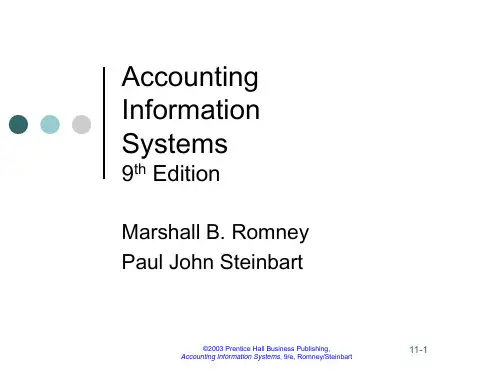
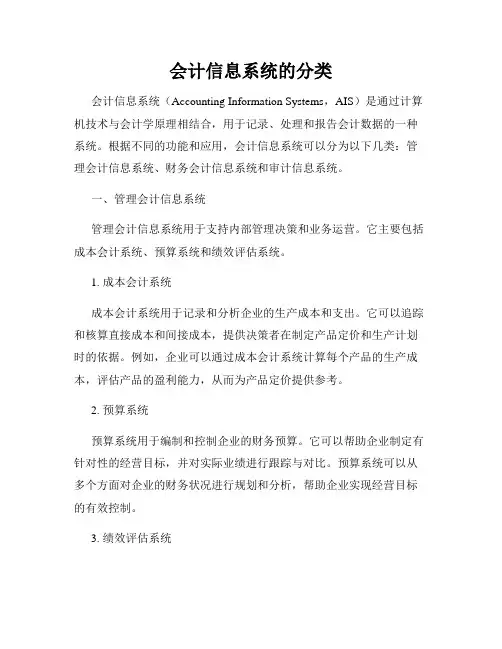
会计信息系统的分类会计信息系统(Accounting Information Systems,AIS)是通过计算机技术与会计学原理相结合,用于记录、处理和报告会计数据的一种系统。
根据不同的功能和应用,会计信息系统可以分为以下几类:管理会计信息系统、财务会计信息系统和审计信息系统。
一、管理会计信息系统管理会计信息系统用于支持内部管理决策和业务运营。
它主要包括成本会计系统、预算系统和绩效评估系统。
1. 成本会计系统成本会计系统用于记录和分析企业的生产成本和支出。
它可以追踪和核算直接成本和间接成本,提供决策者在制定产品定价和生产计划时的依据。
例如,企业可以通过成本会计系统计算每个产品的生产成本,评估产品的盈利能力,从而为产品定价提供参考。
2. 预算系统预算系统用于编制和控制企业的财务预算。
它可以帮助企业制定有针对性的经营目标,并对实际业绩进行跟踪与对比。
预算系统可以从多个方面对企业的财务状况进行规划和分析,帮助企业实现经营目标的有效控制。
3. 绩效评估系统绩效评估系统用于度量和评估企业的绩效状况。
它可以收集和汇总企业的各项经营数据,并进行绩效分析和比较。
通过绩效评估系统,企业可以及时了解自身的经营情况,识别问题和改善机会,实现经营目标的有效落地。
二、财务会计信息系统财务会计信息系统用于记录和报告企业的财务数据,满足外部用户的信息需求。
它主要包括凭证录入系统、总账系统和财务报表系统。
1. 凭证录入系统凭证录入系统用于将企业的财务交易记录在会计凭证上。
该系统可以自动检验凭证的合法性,确保财务数据的准确性和完整性。
通过凭证录入系统,会计人员可以方便地对财务交易进行记录和整理。
2. 总账系统总账系统用于对凭证录入系统记录的财务交易进行分类和汇总。
它可以按照会计科目和期间进行总账和明细账的管理,方便会计人员进行账务核对和调整。
总账系统还可以生成各种财务报表,如资产负债表、利润表和现金流量表等。
3. 财务报表系统财务报表系统用于生成和发布企业的财务报表。
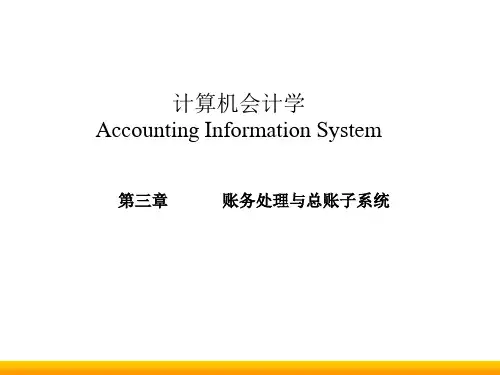
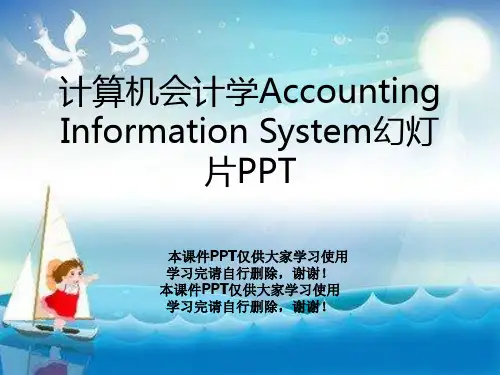
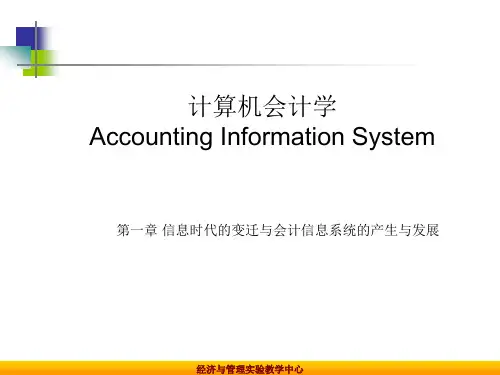
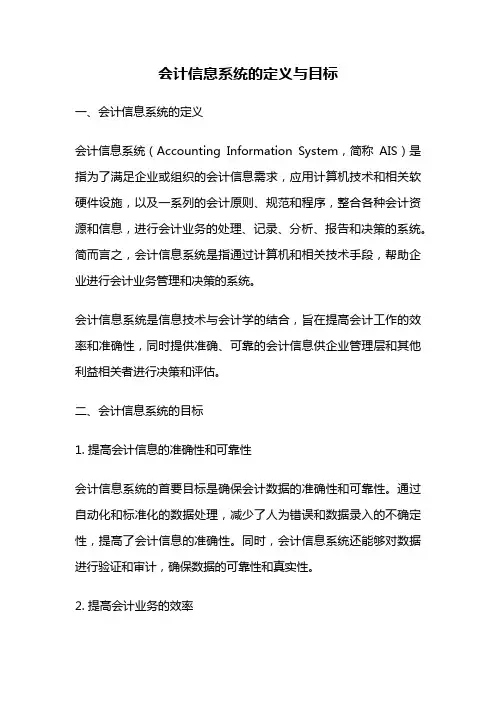
会计信息系统的定义与目标一、会计信息系统的定义会计信息系统(Accounting Information System,简称AIS)是指为了满足企业或组织的会计信息需求,应用计算机技术和相关软硬件设施,以及一系列的会计原则、规范和程序,整合各种会计资源和信息,进行会计业务的处理、记录、分析、报告和决策的系统。
简而言之,会计信息系统是指通过计算机和相关技术手段,帮助企业进行会计业务管理和决策的系统。
会计信息系统是信息技术与会计学的结合,旨在提高会计工作的效率和准确性,同时提供准确、可靠的会计信息供企业管理层和其他利益相关者进行决策和评估。
二、会计信息系统的目标1. 提高会计信息的准确性和可靠性会计信息系统的首要目标是确保会计数据的准确性和可靠性。
通过自动化和标准化的数据处理,减少了人为错误和数据录入的不确定性,提高了会计信息的准确性。
同时,会计信息系统还能够对数据进行验证和审计,确保数据的可靠性和真实性。
2. 提高会计业务的效率会计信息系统的另一个重要目标是提高会计业务的效率。
传统的手工会计需要大量的人力和时间,而会计信息系统可以自动化处理会计数据,大大减少了人工操作的工作量和时间成本。
通过自动处理和集成化的功能,会计信息系统能够快速准确地完成复杂的会计业务流程,提高了工作效率。
3. 提供及时和有用的会计信息会计信息系统的目标之一是提供及时和有用的会计信息。
会计信息系统能够实时记录和处理会计数据,及时生成各类财务报表和管理报告,为企业管理层提供快速准确的财务信息。
同时,会计信息系统还可以根据企业的需求,定制化生成各类报表和分析,为决策和评估提供有用的信息支持。
4. 加强内部控制和风险管理会计信息系统还有一个重要目标是加强企业的内部控制和风险管理。
会计信息系统可以设定权限和审计轨迹,对会计数据的访问和操作进行监控和控制,减少了潜在的人为错误和欺诈行为。
同时,会计信息系统还可以提供风险评估和预警功能,帮助企业及时识别和应对各类风险。
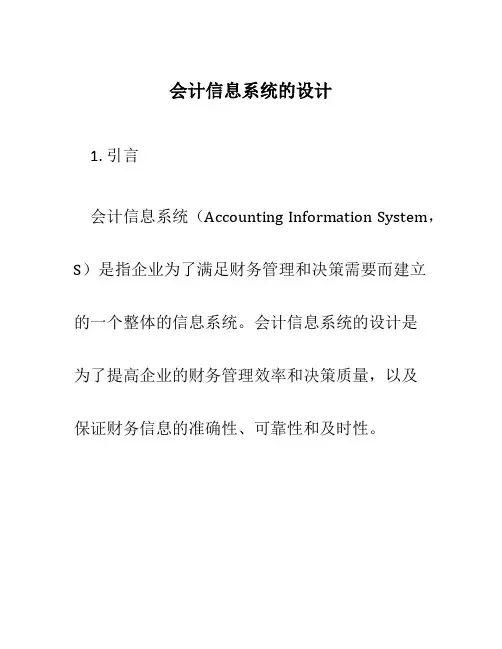
会计信息系统的设计1. 引言会计信息系统(Accounting Information System,S)是指企业为了满足财务管理和决策需要而建立的一个整体的信息系统。
会计信息系统的设计是为了提高企业的财务管理效率和决策质量,以及保证财务信息的准确性、可靠性和及时性。
本文将介绍会计信息系统的设计,包括系统分析与设计方法、系统功能模块、技术平台的选择和系统实施与维护等内容。
2. 系统分析与设计方法系统分析与设计是会计信息系统设计的关键环节,它决定了系统的可靠性和可扩展性。
在系统分析阶段,需要对企业的组织结构、业务流程、信息需求和技术要求进行全面深入的调查和分析。
在系统设计阶段,需要根据分析结果设计出满足业务需求的系统架构和功能模块。
常用的系统分析与设计方法包括结构化分析与设计方法(Structured Analysis and Design,SAD)、面向对象分析与设计方法(Object-Oriented Analysis and Design,OOAD)和敏捷开发方法(Agile Development Methodology)等。
根据实际情况和项目需求,选择合适的方法进行系统分析与设计。
3. 系统功能模块会计信息系统的功能模块主要包括财务管理、成本管理、预算管理、报表分析和决策支持等。
3.1 财务管理模块财务管理模块是会计信息系统中最核心的模块,它包括资金管理、应收应付管理、固定资产管理、往来帐管理等功能。
通过财务管理模块,可以对企业的资金流动和资产负债状况进行全面的监控和分析,帮助企业管理人员进行财务决策。
3.2 成本管理模块成本管理模块主要用于对企业的成本进行管理和控制。
它包括成本核算、成本分析、成本控制、成本预算等功能。
通过成本管理模块,可以实现对企业成本的全面核算和分析,帮助企业管理层制定成本控制策略和优化成本结构。
3.3 预算管理模块预算管理模块用于对企业的预算进行管理和控制。
它包括预算编制、预算执行、预算分析等功能。

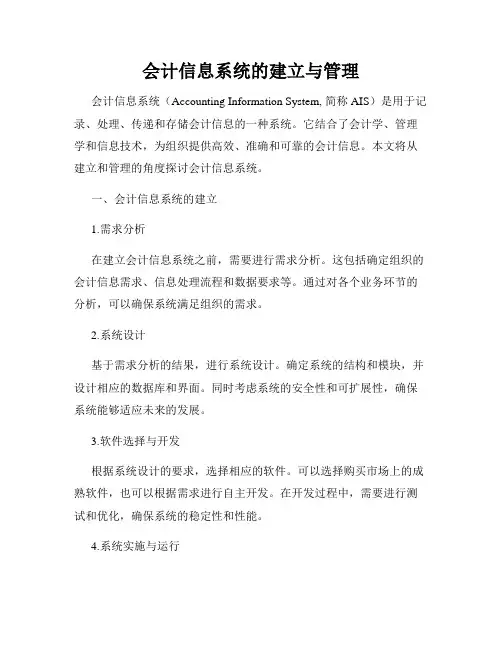
会计信息系统的建立与管理会计信息系统(Accounting Information System, 简称AIS)是用于记录、处理、传递和存储会计信息的一种系统。
它结合了会计学、管理学和信息技术,为组织提供高效、准确和可靠的会计信息。
本文将从建立和管理的角度探讨会计信息系统。
一、会计信息系统的建立1.需求分析在建立会计信息系统之前,需要进行需求分析。
这包括确定组织的会计信息需求、信息处理流程和数据要求等。
通过对各个业务环节的分析,可以确保系统满足组织的需求。
2.系统设计基于需求分析的结果,进行系统设计。
确定系统的结构和模块,并设计相应的数据库和界面。
同时考虑系统的安全性和可扩展性,确保系统能够适应未来的发展。
3.软件选择与开发根据系统设计的要求,选择相应的软件。
可以选择购买市场上的成熟软件,也可以根据需求进行自主开发。
在开发过程中,需要进行测试和优化,确保系统的稳定性和性能。
4.系统实施与运行在完成软件开发后,进行系统实施与运行。
这包括系统的安装、数据迁移和用户培训等工作。
在系统正式上线后,需要进行监控和维护,及时处理系统中出现的问题。
二、会计信息系统的管理1.数据安全管理会计信息系统中的数据是组织重要的资产,因此需要进行数据安全管理。
这包括制定数据备份和恢复策略、设立数据访问权限和审计机制等。
同时,要加强对系统的监控,及时发现和防止潜在的安全威胁。
2.系统维护与升级会计信息系统的维护是确保系统正常运行的关键。
定期进行系统检查和性能优化,及时处理故障和问题。
同时,随着技术的发展和组织需求的变化,还需要进行系统的升级和改进。
3.培训与支持为了保证会计信息系统的有效使用,需要进行培训和支持。
培训可以包括系统操作、数据录入规范和财务分析技巧等内容,提高员工的系统使用能力。
同时,提供及时的技术支持和问题解决,确保用户能够顺利使用系统。
4.性能评估与改进对会计信息系统的性能进行评估和改进是管理的重要环节。
通过收集和分析系统的运行数据,评估系统的性能和效果。
Chapter 1 ACCOUNTING INFORMATION SYSTEMS: AN OVERVIEW
TEACHING TIPS This chapter provides general coverage of many of the text's major themes. It's usually a good idea to indicate how the topics covered in this chapter will be covered in more detail later in the course.
Many instructors will not assign any of the problems from the end of this chapter. This can be done without any loss of overall continuity in the course.
If the course will emphasize internal controls, it might be desirable to cover in class, one of the general cases on internal control from the back of Chapters 4, 8, or 9. This should be done to stimulate student interest, but the instructor should not worry if the students in the course fail to analyze the case correctly.
In some ways, teaching systems can be more difficult than teaching other areas. In many cases, there are no clear-cut debits and credits to be made, and judgment is often required. This can make some students feel uncomfortable. So, it's usually good to emphasize this at the beginning of the course to properly set students' expectations. The point should also be made that systems are an important area of professional examinations.
One of the biggest risks in teaching systems is that it can easily become dry and boring. I have found that the best way to overcome this is to generate as much class discussion as possible on many of the major points in the chapter. Accordingly, I always make class participation about one-fourth of the total course grade. I tell students on the first day of class that as a starting point, I will give all students the same number of points (reflecting a class average) for participation. Then, at the end of the course, I will typically add or subtract 5, 10, or 15 points to/from each student's grade according to the participation. Many students typically stay at the average, so only noteworthy students end up with an adjustment. I always use a seating chart, unless the class is small.
Many of my students have had jobs. So one question that I constantly ask throughout the term is "Has anyone experienced this before in his/her job or otherwise?"
ACCOUNTING INFORMATION SYSTEMS AND BUSINESS ORGANIZATIONS An accounting information system is a collection of resources, such as people and equipment, designed to transform financial and other data into information. Accounting information systems perform this transformation whether they are essentially manual systems or thoroughly computerized.
Information and Decisions. The users of accounting information fall into two broad groups: external and internal. Higher-level managers require less information detail than lower level managers. A distinction might be drawn between two broad classes of accounting information: mandatory and discretionary.
Conceptually, information should satisfy a cost-benefit criterion. In meeting mandatory information requirements, the primary consideration is minimizing costs while meeting minimum standards of reliability and usefulness. When the provision of information is discretionary, the primary consideration is that the benefits obtained exceed the costs of production. 2 1 Accounting Information Systems: An Overview Information Systems. A "computer-based" information system is a collection of computer hardware and software designed to transform data into useful information. Electronic Data Processing (EDP or DP): the use of computer technology to perform an organization's transaction-oriented data processing.
Management Information Systems (MIS): use computer technology to provide decision-oriented information to managers. An MIS provides a wide variety of information beyond that which is associated with DP in organizations. MIS subsystems are not physically independent. Examples of MIS subsystems are as follows: Marketing information system Manufacturing information system Human resource information system Financial information system
Decision Support Systems (DSS): process data into a decision-making format for the end user. DSS serve ad hoc, specific, non-routine information requests by management, including what-if analyses.
Expert Systems (ES): knowledge-based information systems that use knowledge about a specific application area to act as an expert consultant to end-users. An ES differs from a DSS in that a DSS assists a user in making a decision, whereas an ES makes the decision.